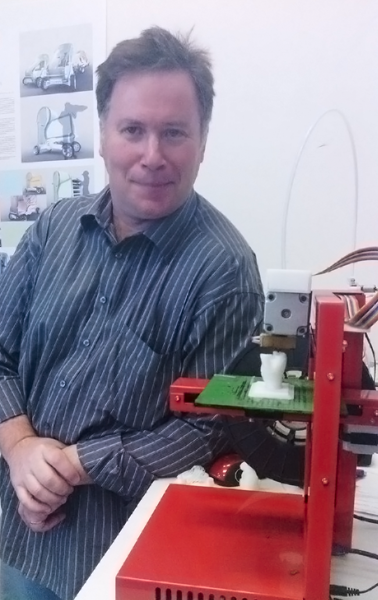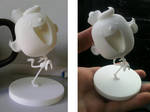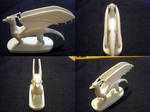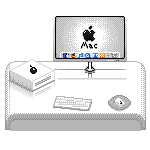3D Printing – An Interview with Professor Olaf Diegel
Don't forget to check the =3D Week Announcement= regularly for upcoming events and contests this week, we've got a lot on!
3D Printing is a way of converting your 3D models into physical real-world objects. It's exciting because most of a 3D artist's life is spent working on things that are never tangible and traditionally haven't existed in the real world, until recently.
Previously, a process called milling has been used to create models of computer objects, This is somewhat like sculpting done by the computer, where you start with a solid mass and cut bits away until you're left with your model! This process is called subtractive printing, because you start with a lot of material, and get rid of bits of it until you're left with your 3D object.
3D printing is an additive process. This means we start with nothing, and add bits on. This means you start with no material, and only add what you need. While there are several methods for 3D printing, the easiest way to imagine it is to consider your 3D model to be created in thin horizontal slices, the printer creates one slice, then lifts the print head a bit and then creates the second slice, and so on, building up to a full 3D model.
This process is getting cheaper and more accessible, which means that 3D artists can now get their work printed without having to rob a bank!
We were very lucky to get an interview with Professor Olaf Diegel, Director of the Creative Industries Research Institute at Auckland University of Technology in New Zealand.

Bonus: Professor Diegel will be joining the Industry Live Chat on Friday!
So make sure to think about any other questions you might have for him about 3D printing and his research. The chat will be held in the Community Relations Chatroom and you can Find out the exact time where you live here.
Professor Diegel is an expert and in the field of rapid prototyping (3D printing) and one of his main areas of interest is the reduction the product development cycle.
:thumb208296458:
Once you've read the following article, check out our 3D Modeling Contest, for a chance to win some fabulous prizes, among which is a chance to get your 3D work printed!
galacticfan compiled an excellent list of questions for Professor Diegel about 3D printing, here's what he told us:
Where do you eventually think 3D printing will lead to in the future?
3D printing will be the next industrial revolution. I believe that, eventually, everyone could have a 3D printer at home that would allow them to manufacture what they need, when they need it. This would entirely change how we do business, and how we live. Instead of having compromised products (in that one size fits all is always a compromise) we will have every product we used customised to perfectly suit out needs which, in turn, could mean a radical change to today’s mass manufacturing culture.
What materials can currently be used for 3D printing?
3D printers can currently print in a variety of plastics, and in metals including aluminium, stainless steel, titanium, and more. 3D printers for tissue engineering applications are also able to print using biological material such as stem cells.
Will the prices of 3D printers ever fall?
Almost every year we are seeing quite dramatic price drops both in 3D printers, and in the material costs of running them. Even today it is possible to buy a 3D printer for less than $5,000, which is not much more than a high-end laser colour printer. Kit set 3D printers can even be assembled for less than $1,000, though the print quality of these is still somewhat unreliable.
There is still, however, a fairly big difference in part quality between the high-end printers (over $40K) and entry-level machines ($4,500 to $40,000). Typically, 3D printers under $100K are still at the level of printing “prototype” parts, whereas the machines above that price range are, generally, capable of printing full-strength “manufactured” parts.
If you could recommend the best value-for-money personal 3D printer, what would it be?
An example of the above under $1,000 printer is the RepRap, for which both the printer itself, and it’s software are entirely open-source, which means that they are completely open for anyone to reproduce, and the modifications of the hardware and software by users is encouraged.
However, if I were to recommend an entry level machine, it would be the Up 3D printer which retails for just under $4,500. It has you up and running within 5 minutes of taking it out of the box and prints pretty decent parts.
Coupled with that, you need an easy to use CAD (Computer Aided Design) system (some sort of 3D package), and for that there are a number of choices, ranging from completely free to a few hundred dollars. Some examples of entry level CAD software include Autodesk 123D, QuickCAD, tinCAD, Google Sketchup, and many many more.
What’s the most complex object that you’ve made on a 3D printer?
The most complex objects I have printed include a guitar filled with spiders, and a lot of components with many moving parts but all printed as a single object.
What are some things 3D printing currently used for, and can you tell us anything about the research you are personally doing?
Current applications of 3D printing, beyond prototyping, include fashion accessories, jewellery, lighting products, medical implants (hip and knee replacements, dental crowns, etc.), mechanical components for cars and aeroplanes, etc.
Some of the research I am involved with includes 3D printing with ceramic materials, printing conductive material inside plastic material (so, ultimately, all your electronics could be 3D printed directly inside the product, and 3D bioprinting.
What are the advantages of additive manufacturing compared to subtractive?
The biggest advantage additive manufacturing (3D printing) has over subtractive manufacturing is that you get complexity for free. With 3D printing, it does not matter how complex your product is as complexity does not affect the part costs.
Another big advantage is material waste. In the case of subtractive manufacturing, you are cutting away material form a solid block to make the part. All the material that you cut off then needs ot e recycled, which is costly and environmentally unfriendly (and some materials cannot be economically recycled). Whereas, with additive manufacturing, there is much less waste material involved.
What advice would you give to someone creating a 3D model to be printed?
The best piece of advice I can give to someone creating a 3D model to be printed is to just try it. A lot of innovation come about from people who are trying something for the first time and don’t know what cannot be done, and are therefore not restricted in their thought process. And start having a conversation to the person who will be doing the 3D printing for you…
You can also check out Professor Diegel's YouTube videos for more exciting information about 3D printing, including examples:
A feature of 3D printed models on DeviantArt!














